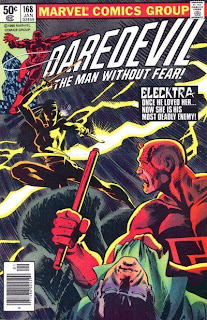Andrew Kannegiesser returns to 24 Panels Per Second this
week to join Dru and Dave on another road trip to Gotham City! This time out,
the trio will be taking a look at Christopher Nolan’s 2008 effort The Dark Knight, the smash hit which
dominated the box office.
Like in the preview post for Batman Returns, we’ll skip by the history of Batman himself to look
at the villains and overall stories which directly influenced the film. To this
end, there is no better place to start than the Joker! The character first
appeared in the first issue of Batman’s own monthly title in 1940, and is the
creation of Jerry Robinson, Bill Finger and Bob Kane. As originally devised,
the Joker was a serial killer and thief, though due to his popularity, his
continued appearances in the comic resulted in the character’s murderous
instincts being toned down.

Unlike most comic super villains, the Joker has never had
a definitive origin, with various possibilities having been suggested over time
by different creative teams. The only point upon which they all
agree is that the Joker had a confrontation with Batman in a chemical factory,
and fell into a vat of chemicals during this confrontation, bleaching his skin
and turning his hair green. Beyond this, the Joker’s life prior to becoming the
clown prince of crime differs wildly, from one origin suggesting that he was a
violent mob hitman, to another which suggests the character was a tragic
everyman. Just as these accounts of the Joker’s origins differ, so too has the
character’s behaviour over the decades, moving from being a serial killer to a
prankster figure, only to move back to his violent ways in the late 1960s.
As one of Batman’s earliest villains, the Joker has made
perhaps the most frequent jump from the comics to other media, being famously
portrayed in the 1960s television series by Cesar Romero…
…and by Jack Nicholson in Tim Burton’s 1989 film Batman…
…and Mark Hamill in the famous Batman: The Animated Series.
Of course, the Joker isn’t the only villain in The Dark Knight, with Harvey Dent, aka
Two-Face, also figuring into the film (though his status as villain here is a
bit questionable). The character first appeared in 1942 in Detective Comics #66, and
was originally named Harvey Kent, a name that would eventually be changed due
to Clark Kent sharing the same last name. Gotham’s district attorney, Dent is hideously
scarred by sulfuric acid during the trial of Gotham’s major mob boss Sal
Maroni, which coupled with prior psychological issues results in Dent becoming
Two-Face, a villain obsessed with duality who can only make a decision based on
the flip of a coin.
While one of the earliest villains in Batman’s history,
the character did not really appear in other media until the 1980s, making his
debut in Tim Burton’s 1989 film Batman,
though only as Harvey Dent. Here, the character is played by Billy Dee
Williams, and is Gotham’s newly elected District Attorney.
Reportedly, Williams was under contract to reprise his
role as Dent in a sequel, but the role was scrapped from appearing in Batman Returns. The character would next appear in Batman Forever, this time played by
Tommy Lee Jones in a slightly more, um, camp performance.
Thankfully, for those who did not enjoy Jones’ take on
the character, Richard Moll voiced a serious performance in the role in Batman: The Animated Series. Here, Dent
is Bruce Wayne’s friend who is dealing with issues of repressed anger, which
are coming to the surface due to the stress from campaigning for his job while
also targeting mob boss Rupert Thorne. The famous scarring of his face does
not happen in court, but results from an explosion during a backroom meeting where the mob trying to blackmail Harvey over the state of his mental health:
But what stories directly influenced The Dark Knight? As with Batman
Begins, the film draws upon several different sources for its narrative,
although unlike that film, The Dark
Knight draws more upon ideas from the comics and less upon direct images
and plots.
At the smallest possible level, the film addresses the
destruction of the Bat-Cave and Wayne Manor in the prior film by looking to the late 1960s and
early 1970s comics. In particular, the film draws upon Batman #217,
in which Batman decides he needs to be closer to his city and shuts down both
Wayne Manor and the Bat-Cave, moving into a penthouse apartment at the
heart of the city.
Likewise, the film’s plot point about Batman inspiring gun-carrying copycats is taken from Frank Miller’s The Dark Knight Returns.
However, in terms of the Joker’s methods of operation and
behaviour, the primary influence upon the film is Batman #1 from 1940. In the comic, the Joker announces his murders
before they happen, and sets about killing his targets through trickery despite
the police presence protecting the victims. Among the victims is the chief of
police and a judge, the latter of which is killed while the Joker pretends to be a
police officer. Furthermore, the Joker’s actions (briefly) whip up public panic. Those
who have seen The Dark Knight will
likely recognize all of these plot points and concepts as appearing in the film
in one form or another.

Additionally, major plot elements are taken from the
limited series Batman: The Long Halloween.
While the series is ostensibly a murder mystery, the comic also traces the fall
of the traditional organized crime families in Gotham and the rise of costumed
maniacs, including the mob turning to some of these villains as they become
increasingly desperate. Again, these plot elements make it into the film in a
highly modified form.
So does The Dark
Knight live up to its reputation? Tune in next episode at the same
Bat-place, and same Bat-blog to find out!























